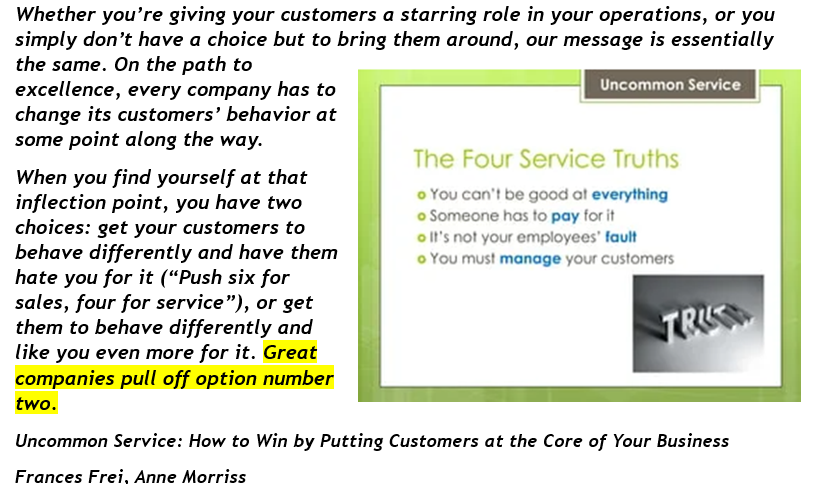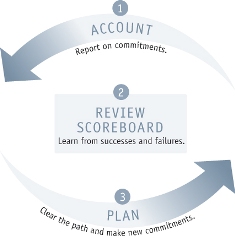In our last blog, You Must Manage Your Customer – Uncommon Service Truth #4, we shared Service Truth #4, You Must Manage Your Customer.
Many businesses fail to appreciate even the possibility they can manage their customers. We’re so busy scurrying to acquire more customers we fail to recognize the value in deciding who we want. Selectivity is just as important with customers as it is in choosing employees. (If you aren’t very good at hiring the right people, this multiplies your challenges with customers!)
How to Manage Your Customer
Frances Frei and Anne Morris's Uncommon Service: How to Win by Putting Customers at the Core of Your Business recommends managing customers in phases:
Phase 1: Getting Control – There are many ways to achieve this. How do you improve managing your employees? Utilization, turnover, evaluations, and rate of advancement, measure employee effectiveness. Are the behaviors you are promoting the right ones? Often our assumptions of customers can be wrong. What impact do customers have on your operation? Test your assumptions. In many cases, you have the data already. A bank, for example, assumed low adoption of their self-service channels reflected low customer awareness. It turned out their customers actively preferred to use tellers, for a wide range of reasons, and the bank’s attempt to dissuade them caused widespread customer resentment. Assuming makes an Ass of you and me!
Phase 2: Actively Involving Customers – Bring your customers into the improvement process. In the world of the customer-operator, the analog to the Andon cord is the customer complaint.
Frei and Morris studied patterns in complaint letters and e-mails. Does your business manage your customers as operating assets? For example, a generic response to complaints sends a clear message. So is a detailed engagement from your chief operating officer. Not responding at all sends another kind of signal. Many companies try to buy off customers to reduce the chance they’ll degrade them on social media. This is a missed opportunity. By treating complaints simply as service recovery moments, companies miss improvement opportunities! As shared in Customer Service Complaints – Good or Bad? what makes managing customer operators difficult also makes them an incredible resource for refining your service model. Frei and Morris’ advice - Ask frontline employees to stop buffering you from customer complaints. What patterns do you see? How do your customers feel about their operating role? What are the systematic opportunities for improvement?
Phase 3: Going All the Way – If you’ve made the first two steps, go to the next. Do what Scott Cook, CEO of Intuit did. Read HBR’s The Contribution Revolution: Letting Volunteers Build Your Business
“I also began to see that user contributions are fueling some of the world’s fastest-growing and most competitively advantaged organizations—in some cases revolutionizing the economics of entire industries by radically shrinking their cost structures.
The challenge for executives is twofold: First, you must learn how to spot opportunities for creating value from user contributions. Second—and here’s the difficult part—in acting on these opportunities, you must overcome natural organizational resistance to the idea of relinquishing significant control to people outside the company. The advice I offer here is based on my personal experience at Intuit—the successes and failures, the moments of exhilaration, and the times when I had to conquer my own fear of putting so much power in the hands of users.”
 Many of you reading this are in service businesses. Uncommon Service recommends, “On the path to excellence, every company must change its customers’ behavior at some point along the way. When you find yourself at that inflection point, you have two choices: get your customers to behave differently and have them hate you for it (“Push six for sales, four for service”), or get them to behave differently and like you even more for it. Great companies pull off option number two.”
Many of you reading this are in service businesses. Uncommon Service recommends, “On the path to excellence, every company must change its customers’ behavior at some point along the way. When you find yourself at that inflection point, you have two choices: get your customers to behave differently and have them hate you for it (“Push six for sales, four for service”), or get them to behave differently and like you even more for it. Great companies pull off option number two.”
To put this into practice, start by assuming you don’t know how your customers are affecting your operations or how well your efforts to manage them are going. Reframe any certainties as hypotheses requiring confirmation. Test them. The data you need is usually right at your fingertips. If not, find out!
To create an environment where everyone is inspired to give their best, contact Positioning Systems to schedule a free exploratory meeting.
Turn your team into a growth organization.
Growth demands Strategic Discipline.
 It’s not enough to design your service model right. Uncommon service is achieved when great organizational design meets a culture of service excellence. Service excellence is a product of design and culture. Next blog, we look at three patterns in organizations' relationship to culture, Clarity: Know Where You’re Going, Signaling: Talk the Talk, and Consistency: Walk the Walk.
It’s not enough to design your service model right. Uncommon service is achieved when great organizational design meets a culture of service excellence. Service excellence is a product of design and culture. Next blog, we look at three patterns in organizations' relationship to culture, Clarity: Know Where You’re Going, Signaling: Talk the Talk, and Consistency: Walk the Walk.
Building an enduring great organization requires disciplined people, disciplined thought, disciplined action, superior results, producing a distinctive impact on the world.
 Discipline sustains momentum, over a long period of time, laying the foundations for lasting endurance.
Discipline sustains momentum, over a long period of time, laying the foundations for lasting endurance.
A winning habit starts with 3 Strategic Disciplines: Priority, Metrics, and Meeting Rhythms. Forecasting, accountability, individual, and team performance improve dramatically.
Meeting Rhythms achieve a disciplined focus on performance metrics to drive growth.
Let Positioning Systems help your business achieve these outcomes on the Four most Important Decisions your business faces:
|
DECISION |
RESULT/OUTCOME |
|
PEOPLE |
|
|
STRATEGY |
|
|
EXECUTION |
|
|
CASH |
|
Positioning Systems helps mid-sized ($5M - $500M+) businesses Scale-UP. We align your business to focus on Your One Thing! Contact dwick@positioningsystems.com to Scale Up your business! Take our Four Decisions Needs Assessment to discover how your business measures against other Scaled Up companies. We’ll contact you.
NEXT BLOG – Uncommon Service Multiplier – Your Company’s Culture.






.jpeg?width=150&height=135&name=Hand%20with%20marker%20writing%20the%20question%20Whats%20Next_%20(1).jpeg)

